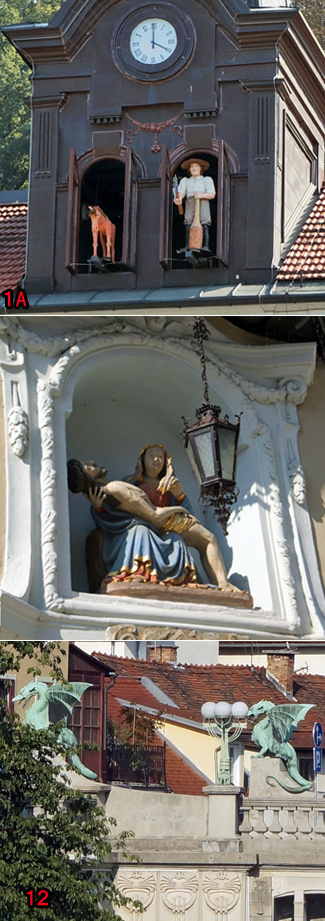クロアチア・スロベニアを巡って 5: 首都リュブリャナ
< 1. Prešeren Square
lies beyond the Triple Bridge. No. 10 in map >
< 1. 三本橋を渡るとプレシェレン広場、地図番号10 >
I introduce Ljubljana
that is the capital of Slovenia.
This city was a
capital city of Balkan Peninsula that I visited in this trip first.
I had expected a
different culture of former Socialist Federal Republic of Yugoslavia.
今日は、スロベニアの首都リュブリャナを紹介します。
今回の旅行で最初に訪れたバルカン半島の首都です。
旧ユーゴスラビアの異文化を期待していたのですが・・・
< 2. This map
indicates our sightseeing route >
< 2. 徒歩の順路を示す地図 >
S, G: We started from and returned at this place.
We walked in order of
these numbers from 3:00 pm to 4:30 pm Sunday, August 30, and these indicate the
shooting locations.
We saw the sights of the
old city by the guidance of a local guide, and enjoyed a stroll.
This city was a European
small and calm town rather than the capital city.
There aren’t large
buildings and old history inheritances here.
Tourists on the street
are not many and this place is a little desolate as tourist spot.
However, I noticed
people were living richly and leisurely in this city while we went through this
city on foot, and by listening to advice of the guide.
S,G: 出発し戻った場所。
私達はこの番号順に歩き、番号は写真の撮影位置を示す。
私達は8月30日(日)の午後3時から4時半まで、旧市街を現地ガイドの案内で観光し、また自由散策を楽しみました。
ここは首都と言うよりは落ち着いたヨーロッパの小さな町でした。
ここには巨大な建築や、古い歴史遺産があるわけでもない。
通りには観光客も少なく、観光地としては少し物足りない。
しかし一巡する内に、ガイドの説明からも人々がのんびりと豊かに暮らする町だとわかった。
< 3. Going on the street
in front of city hall >
< 3. 市庁舎前の通りに向かう >
No.1: Puppet Theater.
No.2: A bronze statue stands on Vodnik Square at
the right side, and a cathedral is over there.
No.4: The street in front of city hall.
番号1: 人形劇場。
番号2: 右手に青銅像が建つヴォドニック広場、その向こうに大聖堂。
番号4: 市庁舎前の通り。
< 4. Cathedral of St.
Nicholas. No. 3 in map >
< 4. 聖ニコライ大聖堂、地図番号3 >
As always, I am
overwhelmed by the beauty of powerful and gorgeous baroque.
いつもながら華やかで迫力あるバロックの美に圧倒される。
< 5. Cathedral of St. Nicholas. >
< 5. 聖ニコライ大聖堂 >
No. 3: A view from the street.
No. 3A,B: The reliefs of two gates made me feel
dignity and novelty.
番号3: 通りから見た外観。
番号3A、B: 両門扉の彫像に重々しさと斬新さがあった。
< 6. 中央に市庁舎が見える、地図番号5 >
Robba fountain at the
left side deals with three rivers flowing through Slovenia.
左のロッバの泉はスロベニアに流れる三つの川をモチーフにしている。
< 7. Beautiful
Ljubljanica riverside >
< 7.美しいリュブリャツァ川沿い >
No.6: A pleasure boat and Ljubljanica river.
No.8: Open cafes and restaurants filled with
citizen line the promenade.
No.9: Francisco church that faces Preseren Square
is seen beyond the Triple Bridge.
The same architect built
this bridge and the church in 1930s.
Two bronze statues stand
on Preseren Square and Vodnik Square, and the name of each Square was called
after two poets of these statues.
Because the statue of
poet without soldier stands, the race history of Slovenian seems to be
symbolized.
番号6: リュブリャツァ川を行き交う遊覧船。
番号8: 市民で賑わっているオープンカフェやレストランが並ぶ散歩道。
番号9: 三本橋の向こうにプレシェレン広場に面したフランシスコ教会が見える。
この橋と教会は同じ建築家が1930年代に建てものです。
プレシェレン広場と前述のヴォドニック広場は共に二人の詩人の名を冠し、その青銅像が建っている。
軍人ではなく詩人の像が立っているところに、スロベニアの民族史が象徴されているようです。
< 8. Various scene 1 >
< 8. 様々な光景1 >
No.7: A view of Ljubljana Castle.
No.11: Outdoor market, and Cathedral is over there.
No.11A: Fresh fruits were on the outdoor market.
We bought raw figs, and
it had been ripe, so it was very sweet.
番号7: リュビリャナ城を望む。
番号11: 青空市場。後ろに大聖堂が見える。
番号11A: 青空市場には新鮮な果物が並んでいた。
生のイチジクを買って食べたが、熟していて甘かった。
< 9. . Various scene 2 >
< 9. 様々な光景2 >
No.1A: At just 4:00, the dolls came out of the
clock tower of the Puppet Theater.
Central photo: It seems statue with combination of crucifixion
of Christ and Virgin Mary.
In earnest Catholic
country, I came across these two motifs well.
No.12: The dragon on the bridge is the city emblem
of Ljubljana.
It was photographed from
the opposite bridge.
It was European dragon
indeed.
番号1A: 4時ちょうど、人形劇場の時計台から人形が出て来た。
真ん中の写真: 聖母マリアと磔刑されたイエスの像だろう。
熱心なカトリックの国では、この二つのモチーフによく出会う。
番号12: リュブリャナの市章になっている橋の袂の龍。向かいの橋から撮影。
いかにもヨーロッパのドラゴンでした。
< 10. Souvenir shop >
< 10. 土産店 >
No.11B: At the riverside of the Outdoor market.
番号11B: 青空市場の川沿いにある。
< 11. Passing through a new urban area from the old city >
< 11. 旧市街から新市街を抜けて >
Though the area that we
passed through was only a part, there were no skyscrapers.
But I had the impression
that this city is rich in green and comfortable.
This continues next
time.
通過したのは一部だが、高層ビルは無く、緑豊かでゆったりとした町という印象を受けた。
次回に続きます。



































